Home | Quotations | Newspaper Articles | Special Features | Links | Search
SPECIAL FEATURE
TRAGEDY ON THE MISSISSIPPI
By Michael H. Marleau
© 2018
~~~~~
"the wickedness of this world - but I haven't time
to moralize this morning."
(Samuel Clemens to Elizabeth W. Smith, Oct. 1859)
~~~~~
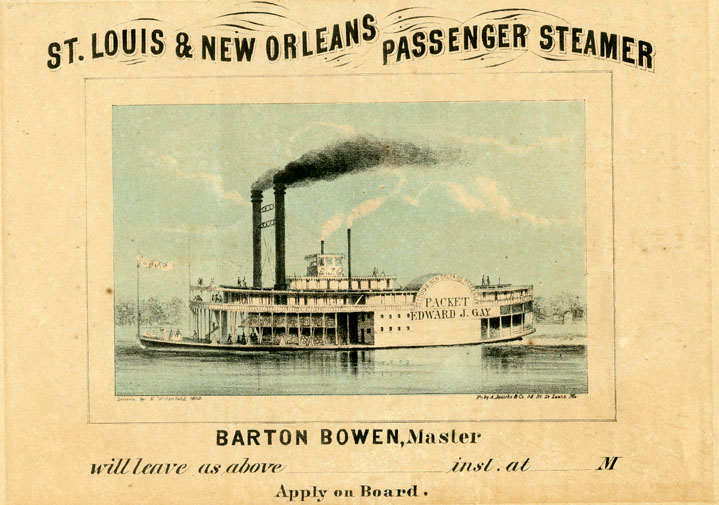
Advertisement for the
Edward J. Gay from the
Historic New Orleans Collection,
acc. no. 1974.25.32.796
~~~~~
As a steersman, and then a pilot, Samuel Clemens, saw, heard and experienced the travails of life on the western rivers. Accidents and death were commonplace. Many of these experiences made it into his writings. Some never would. Very few of Clemens's letters or personal notebooks survive from the time when he was a steamboat pilot. The accounts in this essay documenting his experiences aboard the steamboat Edward J. Gay were found in contemporary reports published in newspapers along the Mississippi river. This is a story of a sixty day period from August to October 1859. This story ultimately ends in a tragedy about which Clemens never spoke and which he tried to erase from his memory. Some scholars may find hints and traces of it in his later writings.
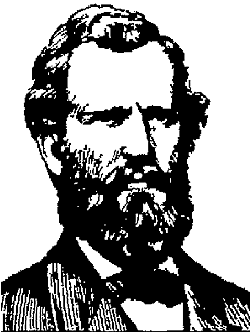 Barton Stone Bowen (1830 - 1868) |
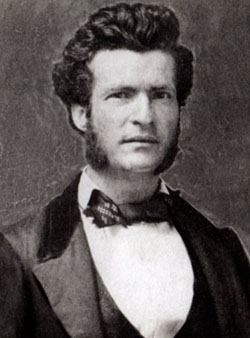 Samuel Clemens (1835 - 1910) |
Samuel Clemens and his friend Bart Bowen were two natives of Hannibal, Missouri who both ended up piloting steamboats on the Mississippi River. Bart, five years older than Sam, was already a steamboat pilot and captain before Clemens went on the river in 1857. On the Aleck Scott, in the spring of 1859, Bowen took Horace Bixby's place as Sam Clemens's mentor until Sam received his pilot's license on April 9, 1859. Later both men were on the Alfred T. Lacey for several trips. While he was on board the Lacey, Sam wrote his now famous "Sergeant Fathom" burlesque sketch, which Bowen had published in the New Orleans Crescent (1). When Sam's brother Henry was severely injured in the explosion of the Pennsylvania in June 1858, it was Bowen who was piloting the Lacey and he helped get Clemens to Memphis to his dying brother's bedside .
By June 1859, Bowen and Clemens had gone their separate ways. Clemens began piloting the steamer Rufus J. Lackland, a passenger freighter. It was the first boat in the new St. Louis and New Orleans Merchant Line. On July 30, 1859, the Lackland arrived at the St. Louis levee and departed the next day without Sam Clemens. He had secured a pilot position along with another pilot, possibly Squire B. Bell, on the new steamer Edward J. Gay (2). His old friend Bart Bowen was now captain and part owner of the Gay.
The sidewheel steamer Edward J. Gay was built in early 1859. The hull was constructed by Primus Emerson at his Carondelet Marine Railway and Dock Company, just south of St. Louis, Missouri.
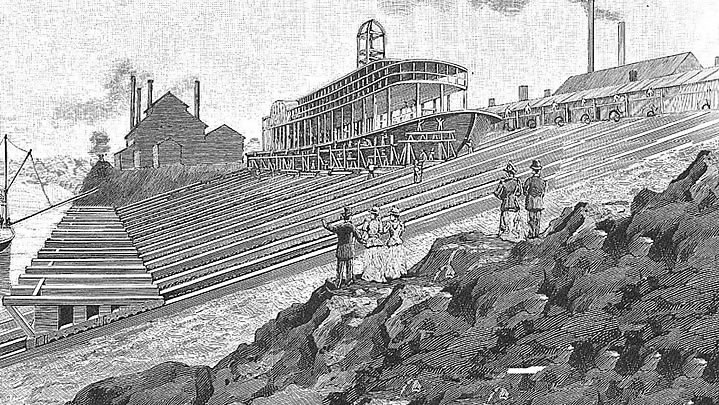
Carondelet
Marine Railway and Dock Company
The Edward J. Gay, named for a successful merchant and banker of St. Louis, became part of the group of steamers called the St. Louis, Cairo and New Orleans Line. It was associated with the Illinois Central Railroad, and it became known as the Railroad Line.
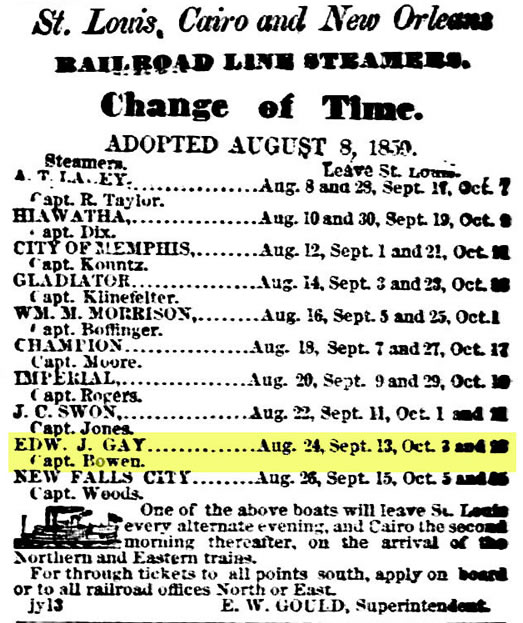
The Gay had a "great capacity for freight, and splendid accommodations for passengers." Captain John Brooks held the office of clerk. James Abbey, a former steamboat pilot and a noted newspaper river correspondent, was the steward who provided "an abundant table" for the Gay (3). Abbey, born in 1820, was from New Albany, Indiana. In absentia during the 1850 census, his mother had listed his occupation as a "Boatman." Abbey had left Indiana for California in 1850. He had kept and published a day-by-day journal of his overland journey in A Trip Across the Plains, in the Spring of 1850. It is likely he and Clemens shared hours of conversation about his traveling to the west and how he documented those experiences.
The next 60 days of Clemens's trip as he piloted the Edward J. Gay are reconstructed from numerous newspaper accounts.
~~~~~
August 2, 1859 - Tuesday. The Edward J. Gay departed St. Louis, Missouri on her first trip downriver to New Orleans. It was a trip of about 1,052 miles down the winding Mississippi river and was expected to take about a week. The Gay left with 1000 tons of freight, drawing eight feet of water.
August 3, 1859 - Wednesday. The Gay arrived at Cairo, Illinois after laying at Cairo Island for part of the night, waiting for the morning train with its passengers. The steamer Ed. Welsh had gone aground near the island. The crew of the Welsh had off loaded her cargo to the island, lightening her enough to float off the bar (4).
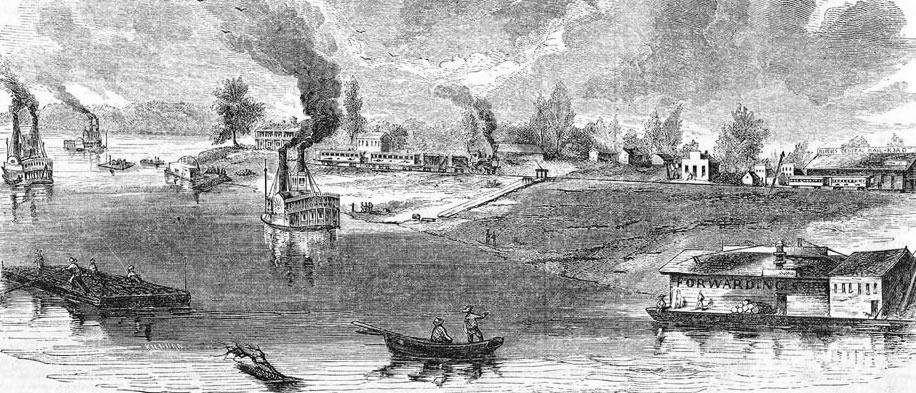
Cairo, Illinois at
the mouth of the Ohio River
August 5, 1859 - Friday. The Gay arrived at the Memphis, Tennessee wharfboat where passengers departed, and freight was off loaded.
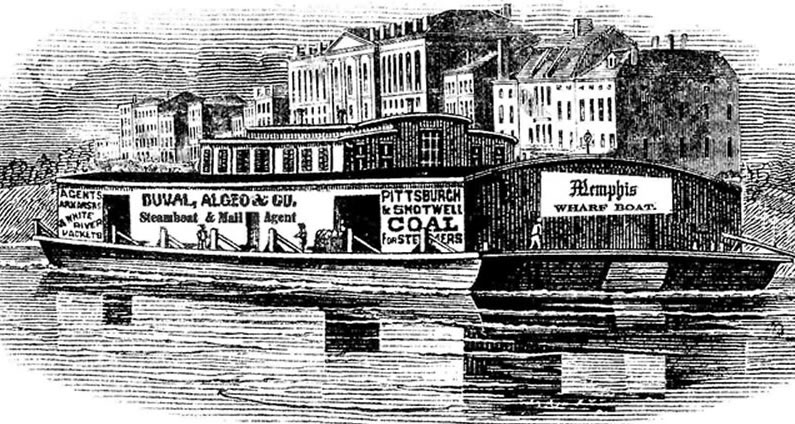
Memphis Wharfboat
The crew of the Gay discovered a three-year-old black girl who had been abandoned on the boat. Her parents had been on board but may have been captured and returned as fugitive slaves or perhaps they left the girl behind to escape a life of bondage. She was taken in by the owner of the wharfboat until her "unnatural" parents or friends could be found. The next day a Memphis newspaper reported the incident (5).
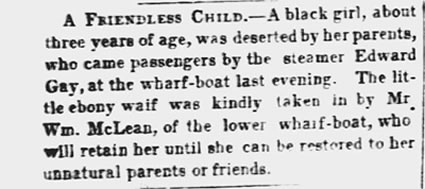
Memphis Daily Appeal,
August 6, 1859, p. 3.
August 7, 1859 - Sunday. When the Gay was passing Choctaw Island, it met the Wm. M. Morrison, also of the Railroad Line. In command was Clemens's "Sergeant Fathom," or Captain Isaiah Sellers. On their trip up from New Orleans, the Morrison made St. Louis in 5 days and 21 hours. This was a remarkable time given the conditions of the river.
August 10, 1859 - Wednesday. After seven days on the river, the Gay reached New Orleans, arriving there in the morning (6).
The two days the Edward J. Gay was in port, she was visited by hundreds of people, who called her the finest boat of the line. Since not one case of "yellow jack" fever had been reported that season, parties from around the area and up the river from the "coast" had visited New Orleans. The "coast" was a tidal portion of the lower Mississippi river, bound on both banks by sugar plantations. A light breeze kept the temperature at 85degrees, as hot as any time that year, but with the high humidity it was miserable.
August 11, 1859 - Thursday. James Peterson, a "free man of color," collapsed while working on the levee and he was taken on board the Gay to recuperate.
August 12, 1859 - Friday. James Peterson died in the morning aboard the Gay. The coroner later recorded sunstroke as the cause of death. The rain continued falling most of the day. About 3 PM the Gay backed out in into the rain-swept river with "four hundred tons of freight and a host of passengers" (7). Up river on the coast with its sugar plantations, the Gay stopped for three hours loading barrels of sugar and molasses. In Morgan's Bend, they met the heavily freighted John J. Roe. Then at the "mouth of the Red river" was the Alfred T. Lacey. As previously noted Clemens and Bowen had both served as pilots on the Lacey, where Clemens wrote his burlesque of Captain Sellers. On Clemens's recent return to New Orleans, the Daily Crescent had noted "our friend and correspondent 'Sargent Fathom' holds forth on the Gay" (8).

Daily Delta,
August 13, 1859, p. 2.
August 14, 1859 - Sunday. The day was clear and pleasant. Since steamboating was a business enterprise, the topic among the officers was the possible damage to the cotton crop from the recent rains. Later at Vicksburg the Gay met the huge Maria Denning, which had picked up a load of mules at Cairo.
Below Cairo, most islands had their names, but all were numbered, one to ten went down to New Madrid and so on down to near New Orleans.
August 15, 1859 - Monday. Up river at Lake Providence, the Gay met the Hiawatha, which was several days behind schedule. At Island 76, they met the Planet, on her second trip down since having been laid up at St. Louis "for some time" (9).
August 16, 1859 - Tuesday. It was cloudy with the threat of rain. At Island 64 was the City of Memphis. Recently her mate Mr. Shannon had been killed by a deck hand at Cairo. About 8 PM the Gay arrived at Memphis, traveling there from New Orleans in just over four days. The officers blamed their tardiness on the time lost on the coast loading sugar and molasses. They unloaded several hundred bags of salt, dozens of barrels of sugar and fifty tons of merchandise. This helped reduce the draft of the Gay on the trip up a falling river.
August 17, 1859 - Wednesday. The weather was getting hotter: "ice cream and frozen lemonade" were in demand. At Ashport, Tennessee the Gay met Captain Klinefelter's steamer Gladiator, and later the new Ben Louis on a maiden trip to Memphis. The Ben Louis was a Missouri river boat and was now part of a three-boat tri-weekly line between St. Louis and Memphis.(10).
August 18, 1859 - Thursday. The morning was cloudy and cool while the Gay was unloading fifty tons of freight at Cairo. After having taken a family trip east, Captain John Bofinger was back on the steamer Wm. M. Morrison, which was also at Cairo, awaiting the arriving trains that evening. Isaiah Sellers was probably back as one of the pilots. The Wm. M. Morrison was the only vessel from St. Louis that morning.
On the Gay the topics of interest were the sand bars between Cairo and St. Louis. On the Morrison, the pilots were describing the river as "six feet, and as crooked as a pig's tail in acorn time."
Setting off by 8 PM, the Gay was soon at Goose Island, finding six and a half feet of water on the bar at the head of the island. They passed the steamer Hannibal, which had departed Cairo hours before. They met the J. H. Dickey (a boat Clemens had been on the year before) at Commerce, Illinois. Further on, the southbound D. G. Taylor was at the foot of Cape Girardeau Bend. With the leadsman pronouncing the depths for the pilot, the Edward J. Gay was creeping along avoiding the bars (11).
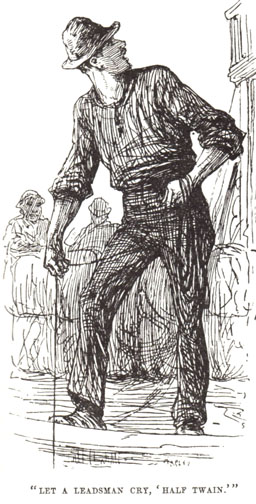
Leadsman illustration
from the first edition of Life on the Mississippi, Chapter 13.
August 19, 1859 - Friday. It was cloudy and cool in the morning with grumblings that "we ought to have been at the Levee this morning early." A bad rainstorm developed, so in company with the diminutive river steamer Undine from the Ohio, the Gay tied up to the bank, losing two hours. Slowly proceeding on finding just six and half feet over the bar at Liberty Island, they met the Champion at the head of the island. The bar at Hat Island had seven feet of water over it. They also observed the steamer T. L. McGill. Both vessels were working their way down river to Cairo. The Edward J. Gay arrived at St. Louis at noon, making the run inside of six days, despite bad weather and river conditions, proving her to be the best steamer on the river at the time. In the business of steamboating, vessels, captains and pilots, all trade on their reputations and speed is of utmost consideration (12).
August 21, 1859 - Sunday. The reports from down river revealed the danger facing the Railroad Line vessels traveling between St. Louis and Cairo on a falling river.
According to an interview given by former pilot Major John B. "Jack" Downing many years later, it was probably on this date that the Gay was “crossing from Goose Island to the Missouri shore, a very shoal place.” A few "River Inspectors" and out of work pilots were in the pilothouse observing the state of the river down to Cairo. Downing recalls Clemens was telling one of his yarns and fellow pilot Squire B. Bell was at the wheel and ran the Gay aground on the bar. The boat was grounded for half an hour before working her way off. "Bell made the air blue with all the swear words in his vocabulary in declaring that, if it hadn't been for Sam Clemens's story, he would have kept the boat in good water."
The New Falls City, bound north, was grounded at Goose Island. Passing down the river was the Imperial, which also grounded at the same bar. St. Louis boats were advised not to load more than six feet. Still on the bar at Goose Island the New Falls City decided to lighten herself off. Once off the bar she reloaded her freight and grounded again in about 200 yards. The Imperial got off and passed Cairo. The New Fall City finally arrived at St. Louis after getting off Hat Island where she had left 200 sacks of salt. Such was the state of the river when the Edward J. Gay and her pilots departed St. Louis for another trip down south. (13).
August 24, 1859 - Wednesday. Steaming down river to Cairo, the Gay scrapped on the river bottom above Cape Girardeau. Learning that it was seven feet from the Cape Girardean on to Cairo, the Gay took on additional freight.
August 25, 1859 - Thursday. With her pilots skillfully avoiding trouble, the Gay arrived at Cairo in the evening. Preparing to leave Cairo that night for the south was the independent steamer New Uncle Sam, popularly referred to as the Sam, having departed St. Louis the day before the Gay (14).
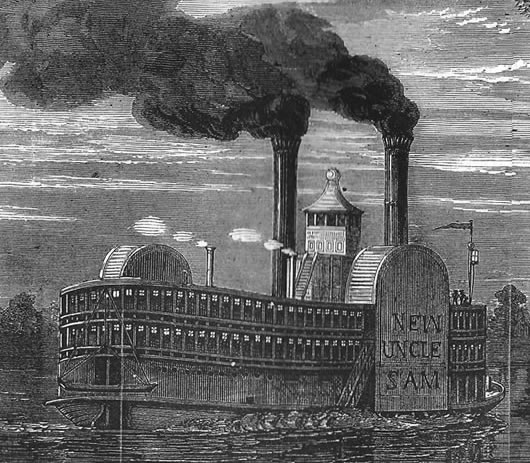
New Uncle Sam
would become a fierce competitor for speed and position on the river.
(Depiction of New Uncle Sam by Michael H. Marleau.)
At Cairo, there were two wharfboats: one for freight and the other for passengers, both owned by the same company. At times the company had an abundance of freight, but rather than let their competitors' boats have it at fair rates, the wharfboat company held it for the Railroad Line boat. The practice prompted some newspapers to describe the Railroad Line as the "Mob" line because the owners of the boats of the line worked together and shared the profits, squeezing out competitors. One such news report described the Sam "lying at the passenger depot . . ., and the E. J. Gay, was at the freight depot." The passengers arriving on the trains were "carried past the Sam to the Gay, half a mile." Those "wishing to take the Sam were compelled to walk that distance through mud and run to take their choice of boats." The Sam did manage to get "75 cabin and 100 deck passengers," as well as some reshipped freight from several vessels from up the Ohio. Also shipped were "150 head of stock," when she departed that night. Overnight the Gay was loaded with "a large lot of dry goods and other freight," before departing Cairo the next morning (15).
August 26, 1859 - Friday. The Gay departed Cairo.
August 27, 1859 - Saturday. The Gay was noted at Ashport below Island 26, further upriver the New Uncle Sam was now at Island 21, well behind the Gay. There are ways a vessel that far ahead could be run down and passed. Perhaps the Sam, like the steamer Crescent City, was grounded for several days at Island 21. Later that evening the Memphis packet J. H. Dickey was proceeding up and met the Gay, below Beef Heart Island, or number 49 at "Wampanoag" bar. Further up she found the Sam at Island 36. That night the Gay arrived at Memphis and soon departed for the south. The Sam arrived early the next morning, still lagging behind the Gay (16).
As the days went by, the competition on the river for advantageous positions would heat up between the New Uncle Sam and the Edward J. Gay.
August 30, 1859 - Tuesday. At some point between Memphis and Vicksburg, the New Uncle Sam had overtaken the Gay. The Sam arrived at Vicksburg about 8 AM well ahead of the Gay. The Gay probably had a mechanical issue with one of her engines, the beginning of a recurring problem she would have on her next upriver trip.
August 31, 1859 - Wednesday. The Gay arrived about 5 AM at Vicksburg. Cotton planters in the vicinity were all working their slaves to pick and get the crop down to market as quickly as possible. All the Vicksburg packets were enjoying a brisk business. They come down to New Orleans "loaded from the guards to the hurricane roof, with old king cotton." The Natchez brought down 3,261 bales, which was "the largest load so far" of that season (17).
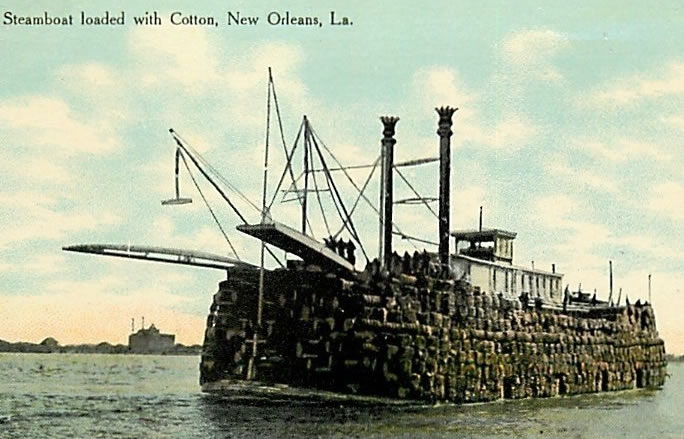
Postcard from the R.
Kent Rasmussen collection
September 1, 1859 - Thursday. The Gay arrived at the steamboat landing in New Orleans late in the day. As they had continued downriver, the pilots had observed that southern rivers flowing into the Mississippi, were "lying very low, confined to their bed." Water in the channels were "so low that even the small fry of 'Dinkeys'" had to tie up for a time. Down on the coast the sugar cane crop was extremely large, and planters felt that if the weather continued, harvesting and grinding would begin early (18).
September 3, 1859 - Saturday. All along the steamboat landing, vessels were departing New Orleans. Smoke emitted from their stacks as crews fired up the boilers to raise steam. The Gay departed that evening just before 6 PM, amid the shouts and cheers and the "waving of hats and handkerchiefs." On board was an old family friend from when the Clemenses had lived in Hannibal, Missouri. All the Hannibal town folks affectionately referred to her as "Aunt Betsey," sixty-four-year-old Mrs. Elizabeth W. Smith.
The Edward J. Gay backed out "with two hundred and eighty tons of freight and a host of passengers, ... in company with some of the fast boats, officered by fast men." One of these fast boats was the New Uncle Sam, departing just before the Gay (19).
September 4, 1859 - Sunday. Early in the morning the Gay lost two hours by reducing speed due to fog. About 5 AM, near Baton Rouge, the vessel "took a wood boat in tow." Still in the fog, the Gay passed the U. S. Mail packet Natchez at Prospects Island. About 9 AM the Gay met the A. T. Lacey just below Bayou Sara. Just above Bayou Sara the Gay met the New Falls City, rumored later that day as being "destroyed by fire." Her captain subsequently telegraphed, "All Well" from Vicksburg. The New Uncle Sam, having taken in tow a couple of wood boats at Morganzie, noticed that the Gay had come in sight down river (20).
Just after 7 PM, in "company with the famous New Uncle Sam" the Gay landed at Natchez. The Sam departed some twelve minutes in advance of the Gay, still jockeying to stay ahead. On board the Sam, it was claimed they had no difficulty in keeping ahead. While on the Gay it was thought the smoke from Sam, indicated an abundant use of pitch, rosin and coal, was being used to increase the heat in the boiler, producing more steam, and thus more speed. About 10 PM that night the tiller ropes on the Sam "got foul" and the boat stopped both wheels in the middle of the river. Before they got started again, the Gay sped past the Sam (21).
September 5, 1859 - Monday. With rain and chill winds blowing, the Sam was once again a short distance ahead of the Gay. However, just beyond Vicksburg, the Gay once again passed the "famous New Uncle Sam under way in Diamond Island bend, after a stern chase of 375 miles." On board the Sam, the story was that "the Gay ran up the bar side of us, and the pilot held the wheel hard down on us." When coming alongside to try and force the Sam to the bank, Captain Bowen of the Gay, hollered out to the pilot of the Sam to stop or be run into the bank, "but he is being rather stubborn, as most pilots are, would not obey." To "avoid a collision," the pilot slowed down, and the Gay went past. Clemens was probably at the wheel of the Gay, as he had seen this maneuver used before (22).
During the night the Sam again passed the Gay. The Gay was "tied up at the bank repairing our piston head on the starboard engine, which worked loose during the night," losing three hours of travel time. These were not new engines; they formerly belonged to the five-year-old retired steamer Oceana, whose hull was then one of the wharfboats at Memphis. The officers on duty on the Gay, waiting on repairs, were cold, but donning thick clothing, sitting by the fire with "morning bitters, were comfortable" (23).
September 6, 1859 - Tuesday. Repairs completed, the Gay was off by 4 AM. Up ahead the Sam had laid at Gaster's Landing on the Arkansas shore. About daylight, one hour into the offloading, the Gay again passed up the Sam on the bank at Gains' Landing. Her crew was off-loading "a large lot of machinery, including a boiler and engine" for some local enterprise. One hour later the freight was out, and the Sam started on its way again (24).
About 10 AM the Gay landed at Napoleon, Arkansas, losing over an hour again making repairs to the piston head. Shortly after 11 AM they were under way again, and still ahead of the Sam. "The Sam came along in hot pursuit, but as our business was urgent, we left her hammering away in our rear, smoking and steaming." When the Sam got above Napoleon, her pilot finding the water shoal, and fearful of grounding, slowed the vessel down choosing the safe way. The Sam then made every stop and "picked up all the freight and people in sight" (25).
Steaming up river the Gay, while passing Choctaw Island, met the R. J. Lackland, which unloaded one hundred wheelbarrows and a quantity of plows at Memphis. The City of Memphis at Island 74 passed down with a fair trip. That evening the Gay, three days out passed Island 65 (26).
September 7, 1859 - Wednesday. The Gay arrived at Memphis early in the morning, having made it in three and a half days. The vessel laid two hours at Memphis, again repairing its crippled engine. At President's Island the Illinois was passing down and at Diamond Point, along the main shore laid the recently sunken Atlantic. The vessel "while under full headway" took a shear on the pilot and the bow was run up on a "bluff bank." Her stern was in deep water while the bow was on shore. The Atlantic was soon repaired and refloated (27).
That night the Gay met the Memphis packet Ben Lewis at Island 21, which was "behind time, caused by the wretched state of the river." Nine feet of water was reported at Island 18, which above Memphis was the most shoal point (28). As one of the pilots of the Edward J. Gay, Sam Clemens appeared reckless and foolhardy, but it was his developing confidence in his training and knowledge gained that allowed him to navigate these shoals.
September 8, 1859 - Thursday. In the morning, at the foot of Island 10, the Gay passed the slower D.G. Taylor, and found the big freighter J. J. Roe below Columbus, Kentucky. About 10:30 AM the Gay landed at Cairo, on "a miserable low river . . . in four days and eleven hours." The Gay left Cairo about 3 PM, after unloading a lot of freight for reshipping up the Ohio river. With less freight the vessel was piloted over the bar above Cairo in six feet of water. Further up river was the John Walsh, one of the Railroad Line, grounded at Sheppard's just above Bainbridge. The Walsh had been in that predicament for days, trying to get out of the river to Cairo. The Gay, came along side, but unable to render assistance, provided several cords of wood. While the Walsh was aground, two negro slaves escaped from the boat and crossed the river to the free state of Illinois. Up river, below Goose Island, the Gay met the Memphis and St. Louis packet Platte Valley (29).
September 9, 1859 - Friday. The morning dawned cool and cloudy with only five feet of water in the channel from Cairo to St. Louis. At Tower Island, the Gay passed the Champion, and the Maria Denning at Hat Island, both hard aground. The Gay soon arrived at St. Louis (30).
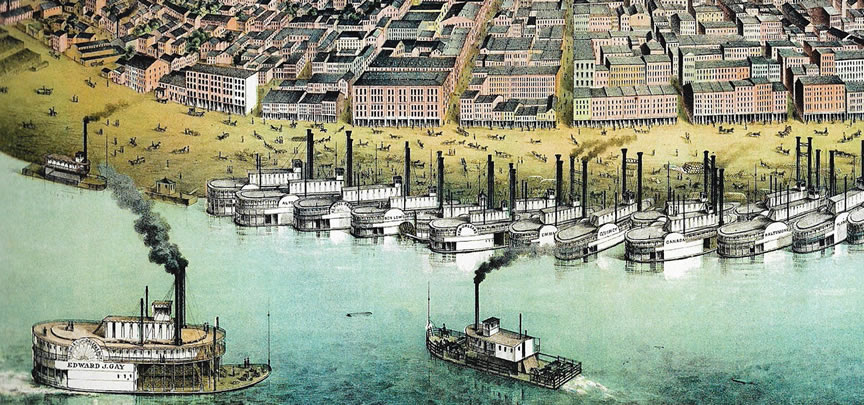
Detail from lithograph
"Our City - St. Louis" circa 1859
featuring the Edward J. Gay in the lower left corner
by A. Janicke & Co.
September 13, 1859 - Tuesday. The Edward J. Gay departed St. Louis in the evening. The rival steamer New Uncle Sam had left the day before. On their way to Cairo boats were hard aground: the Champion at Tower Island and the Maria Denning, since Saturday morning, at Bird's Point on the Missouri shore opposite Cairo.
September 14, 1859 - Wednesday. The New Uncle Sam arrived at Cairo in the evening and loaded 200 tons of freight from Louisville and departed that night (31).
September 15, 1859 - Thursday. The Gay arrived at Cairo during the night and spent the night across the Ohio river on the Kentucky shore at Eliza's Point awaiting her turn in port.
September 16, 1859 - Friday. The Gay departed Cairo in the morning after taking on freight and passengers. In the papers there was talk of replacing the captain of the Denning as being inept (32). Steamboats were working their way down to Memphis on a river that continued to recede steadily. At Memphis the New Uncle Sam arrived late in the evening and laid at the wharf that night.
September 17, 1859 - Saturday. The Gay was expected at the Memphis wharf that morning. Late that night the New Uncle Sam was reported "above Greenville, sparring."
This bar was between Memphis and New Orleans. Sparring was a means of actually lifting the bow of a steamboat, as if on crutches, up and off a sand bar with stout spars, block and tackle, and the use of the paddle wheels to lift and move the boat through successive stages over the bar. This booming a boat off a bar was by its very action known as "walking the boat" or "grass-hoppering." Two long sturdy spars were forced forward from the bow on each side of the boat into the sand of the bar at a high angle. Near the end of each spar a block was fastened with a strong rope or hawser passing through the pulleys which went down through a pair of similar blocks secured on the deck near the bow. The end of each hawser went to a capstan, which when turned would tighten and with its weight on the spars, slightly lift the bow of the boat. Engaging the paddle wheels forward and by the placement of the spars caused a lifting of the bow off the sand bar and moving the boat ahead perhaps a few feet. By backing the wheels, the boat could be brought off the bar if it was deemed hazardous to go forward over the bar. This was laborious and dangerous work for the crew even with a steam driven capstan.
After getting off the bar, the Sam was noted at Lake Providence.
September 18, 1859 - Sunday. The Gay was "at the foot of Island 76," and later in the day at Grand Lake.
September 19, 1859 - Monday. The Denning was noted "sounding" at the foot of President Island.
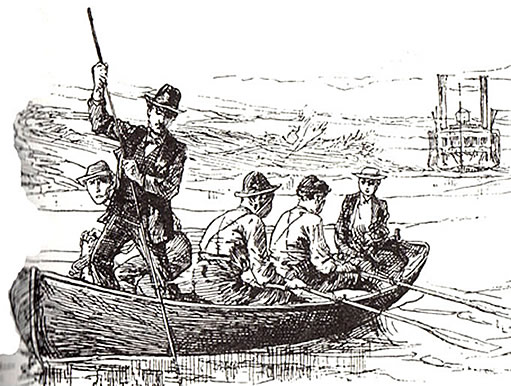
"Sounding"
from the first edition of Life on the Mississippi, Chapter 12.
Sounding was conducted ahead of the steamboat by a pilot with a small crew in the steamer's yawl. The pilot by probing with a pole or a lead line would search for the channel. The steamer would follow a distance behind the yawl (33).
September 21, 1859 - Wednesday. Both the New Uncle Sam and the Edward J. Gay arrived at New Orleans (34).
September 23, 1859 - Friday. All the southern rivers flowing into the Mississippi were still low, and stacks of cotton sat on their banks waiting for the water to rise. A large number of boats at Algiers, just across the river from New Orleans, were ready to get on the river. With these boats laid up, getting a steamboat crew was still hard to assemble at this time in New Orleans. Some packets were offering fireman and deck hands a salary up to eighty dollars a month (35). (Online inflation calculators rate that amount as the equivalent of over $2,200 in the year 2018.)
The Edward J. Gay departed New Orleans about 6 PM. Her rival, the New Uncle Sam had skedaddled the day before. That night in a dense fog, the pilots of the Gay came upon vessels tied up to the banks, not willing to venture out upon the river. The older boatmen on board believed the river was as low as they had ever seen it.
September 24, 1859 - Saturday. The Gay was at Natchez. Also there was the Maria Denning, still trying to get to New Orleans. Above Natchez, below Grand Gulf, were the New Falls City and the A. T. Lacey, both boats that Clemens had previously piloted.
September 25, 1859 - Sunday. Early in the morning, below Vicksburg, at the foot of Big Black, the Gay met the Hannibal. The Hannibal had taken three days to reach Big Black, on their way from Memphis. Under better conditions it would take less than half that time.
September 26, 1859 - Monday. At Greenville Bar the J. C. Swon was hard and fast aground when the Gay arrived and pulled her off (36).
The officers of the Gay visited a wharfboat where they found survivors of the steamer Irene that had struck a snag and sank a few days earlier when approaching the mouth of the Arkansas river where it meets the Mississippi. Bowen and his officers found a severely injured woman identified as Mrs. Lackey and her two children who had been on the Irene. A daughter, aged sixteen had suffered a broken neck when a bale of cotton fell on her. Mrs. Lackey had sustained severe chest injuries from falling timber. A younger son had escaped without injury. First taken to Napoleon, Arkansas, they had then robbed of all they possessed, four dollars. Mrs. Lackey and her children had lain several days on the wharfboat and had begged without success for passage to St. Louis. Captain Bowen generously took the injured aboard the Gay, tried to make them comfortable, and raised a purse of $40 from among the passengers for their relief. However, the young girl soon died, and before reaching St. Louis, Mrs. Lackey also died (37).
September 27, 1859 - Tuesday. Just after dark, the Gay approached Memphis. Upon nearing the wharf, Captain Bowen was at his post on the hurricane deck when the vessel was landing. A man in a skiff was spotted a short distance ahead, directly in front of the Gay. The man in the skiff yelled out not to be run over. Bowen told him to get out of the way, but there was not time. The pilot ordered the engines to be stopped, but it was too late. The Gay went "over the skiff, crushing it to atoms," the man was seen no more and believed killed instantly. The account of the fatal accident in the Memphis paper was given by departing passengers, not the officers of the Gay (38). The odds are high that Sam Clemens was the pilot on duty at the time of the tragedy. It would be a long three days upriver to St. Louis for Clemens.
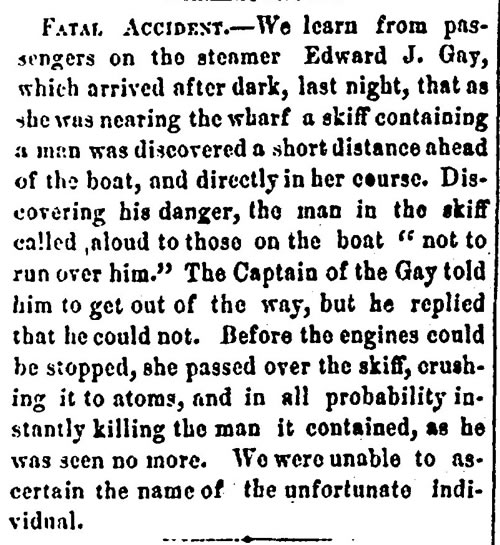
Memphis
Daily Avalanche, September 28, 1859, p. 3.
October 1, 1859 - Saturday. The Edward J. Gay arrived at St. Louis.
October 4, 1859 - Tuesday. The Gay departed St. Louis for a fourth trip down to New Orleans. Sam Clemens was not on board.
~~~~~
No further news items regarding the man's identity or inquests into his death have been found.
Clemens
stayed at home in St. Louis a while with his mother Jane Clemens who was living
with her daughter Pamela and son-in-law William Moffett. The first surviving
letter that Clemens wrote after his time aboard the Edward J. Gay was
to "Aunt Betsey" Smith who was living a few miles from Cape Girardeau.
Her letter to the family does not survive but she had apparently written to
Jane Clemens to inquire about future trips on the river to St. Louis. Clemens
answered the letter for his mother describing himself as in a "lamentable
state of ignorance." He further explained, "I made but one trip
on the packet after you left, and then concluded to remain home awhile."
Clemens wrote that he was "in a bad way again" claiming love, "in
its most malignant form." Could it possibly have been remorse, not wishing
to reveal his role in a man's death to family and friends? He ended the
letter by writing, "the wickedness of this world - but I haven't
time to moralize this morning" (39).
Before two weeks had passed,
Sam Clemens was visiting the rooms of the Pilots Association in St. Louis
where he sought a new position. While there he would talk to fellow pilots
and read the posted pilot reports, educating himself on the conditions of
the river. After nearly a month at home he was traveling south again, as a
pilot on the steamer A. B. Chambers.
In 1883 Clemens would publish his experiences regarding his time on the river in Life on the Mississippi. In chapters 10 and 11 he described the "mortal hatred" steamboat pilots held for operators of "small-craft" who were an "intolerable nuisance" who often threatened lawsuits against a boat. Clemens described "small-fry rascals" who approached steamboats in skiffs asking for newspapers and journals the clerks on board were known to pass out as they traveled up and down the river.
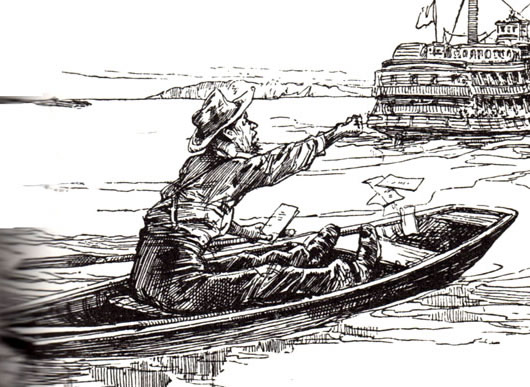
Illustration from the
first edition of Life on the Mississippi, Chapter 11.
In 1899, Jack Downing wrote to Clemens apparently asking him questions about their time spent on the Mississippi with Captain Bart Bowen. Clemens replied on February 26, 1899 that he had worked with Bowen on the A. T. Lacy but he made no mention of the Edward J. Gay.
Downing again wrote to Clemens on February 21, 1907 asking about the time almost fifty years ago when he and fellow pilots had inspected the Mississippi with Clemens and pilot Squire B. Bell. Clemens's reply, dictated to his secretary Isabel Lyon, is full of evasiveness and denial. He wrote he was under the impression he had never seen Bart Bowen again since June 1858 when Bowen had helped transport him to Henry Clemens's dying bedside in Memphis. He described Bowen as a man he held in "undiminished honor to this day." In a half-hearted concession he concluded, "I seem to remember the river-inspection trip you speak of, & that the boat was the Edward J. Gay; but it is very, very dim & uncertain--as vague & shadowy as are the long-vanished faces that looked out over the breast-board, & whose blurred features you have called up out of the grave of my memory" (40).
Bart Bowen died in 1868, still in his thirties. He apparently left no written account of what might have happened that late September evening in 1859 just after dark. Sam Clemens effectively maintained silence on it for the remainder of his life.
________
REFERENCE NOTES
(1) "Our friend Sargent Fathom ...," New Orleans Crescent, May 17, 1859, p. 7. "The Letter ...," New Orleans Crescent, May 19, 1859, p.7. "We find in the Memphis Avalanche…" Cincinnati Daily Gazette, August 27, 1870, p. 4. SLC to Mary E. Clemens, June 18, 1858 in Mark Twain's Letters, Volume 1, 1853-1866, edited by Edgar Marquess Branch, Michael Frank, and Kenneth M. Sanderson. University of California Press, 1988, p. 83.
(2) "River Intelligence," New Orleans Crescent, June 17, 1859, p. 4. "River Intelligence," New Orleans Crescent, June 28, 1859, p. 7. "Soleleather Cultivates His Taste for Music," New Orleans Crescent, July 21, 1859, p. 4. Branch, Edgar M., "A New Clemens Footprint: Soleleather Steps Forward," American Literature, Dec. 1981, pp. 497-502.. "Port Of St. Louis," Daily Missouri Republican, August 2, 1859, p. 4.
(3) "Port Of St. Louis, River News: The New St. Louis built Steamer Edward J. Gay," Daily Missouri Republican, June 28, 1859, p.4. "Port Of St. Louis," Daily Missouri Republican, August 2, 1859, p. 4. "Mr. James Abbey . . . ," Evansville Daily Journal, May 25, 1853, p.2. "The Greatest Race On Record-Extraordinary Run Of The A. L. Shotwell," Memphis Daily Eagle And Enquirer, May 27, 1853, p 2.
(4) "Port Of St. Louis, River News," Daily Missouri Republican, August 3, 1859, p. 4. "The Edward J. Gay . . ., Louisville Daily Courier, August 5, 1859, p. 4. "Port Of St. Louis, Cairo Correspondence, Cairo, Daily Missouri Republican, August 3, 4 & 5, p. 4.
(5) "A Friendless Child," Memphis Daily Appeal, August 6, 1859, p. 4.
(6) "Port Of St. Louis, River News & Memoranda - Steamer Wm. M. Morrison," Daily Missouri Republican, August 11, 1859, p. 4. "River Intelligence," Daily Delta, August 11, 1858, p. 4.
(7) "Port Of St. Louis, River News, The steamer Edward J. Gay . . .," Daily Missouri Republican, August 20, 1859, p. 4. "River Intelligence, The weather is . . .," Daily Delta, August 13, 1859, p. 4. "Sunstruck," Daily Delta, August 13, 1859, p. 2.
(8) "Port of St. Louis, River News," Daily Missouri Republican, August 20, 1859, p. 4. "The New St. Louis . . . Packet Edward J. Gay . . .," New Orleans Daily Crescent, August 11, 1859, p. 8.
(9) "Port Of St. Louis, River News, The steamer Edward J. Gay . . .," Daily Missouri Republican, August 20, 1859, p. 4. "By dispatch from Cairo . . .," Louisville Daily Courier, August 12, 1859, p. 4. "Steamboat Departures, Hiawatha. . . ," New Orleans Daily Crescent, August 13, 1859, p. 8. "River and Steamboat News," New Albany Daily Ledger, July 16, 1859, p. 3.
(10) "Port Of St. Louis, River News, The steamer Edward J. Gay . . .," Daily Missouri Republican, August 20, 1859, p. 4. "River News," Memphis Daily Avalanche, August 3, 1858, p. 3.
(11). "Port Of St. Louis; River News, The steamer Edward J. Gay . . .," Daily Missouri Republican, August 20, 1859, p. 4. "Port Of St. Lois; River News, Cairo Correspondence," Daily Missouri Republican, August 19, 1859, p. 4.
(12) "Port Of St. Louis; River News, The steamer Edward J. Gay . . .," Daily Missouri Republican, August 20, 1859, p. 4. "River and Steamboat News," New Albany Daily Ledger, August 15, 1859, p. 4.
(13) "Piloted with Mark Twain," Cincinnati Enquirer, September 12, 1909, p. 24. Squire B. Bell, born about 1829, was listed as a pilot in the 1850 census and later a captain of steamboats. Both Bell and Downing were mentioned by Clemens in Life on the Mississippi. "Port Of St. Louis, River Correspondence; Cairo Correspondence," Daily Missouri Republican, August 23, 24, 25, and 26, 1859, p. 4.
(14) "Port Of St. Louis; Cairo Correspondence, August 26, A.M.," Daily Missouri Republican, August 27, 1859, p. 4. "E. A. Ogdon . . .," Louisville Daily Courier, August 29, 1859, p. 1.
(15) "Port Of St. Louis; Cairo Correspondence, Cairo. August 26, A.M." Daily Missouri Republican, August 27, 1859, p. 4. "River and Steamboat News," New Albany Daily Ledger, August 27, 1859, p. 4.
(16) "Memoranda: The John Bell left Memphis Friday," Louisville Daily Courier, September 2, 1859, p. 4. "For New Orleans," Daily Illinois State Journal, August 19, 1859, p. 2. "Port Of Memphis," Memphis Daily Appeal, August 28, 29 and 30, 1859, p. 4. "Memoranda: The steamer John H. Dickey," Daily Missouri Republican, September 1, 1859, p. 4.
(17) "Vicksburg," New Orleans Crescent, August 30 and 31, 1859, p. 1. "Vicksburg," [New Orleans] Picayune, August 31, 1859, p. 1. "Port of St. Louis, River News: Steamer Edward J. Gay, New Orleans," Daily Missouri Republican, September 11, 1859, p. 4.
(18) "Port Of St. Louis, River News: Steamer Edward J. Gay, New Orleans," Daily Missouri Republican, September 11, 1859, p. 4.
(19) "Steamer New Uncle Sam, St. Louis, September 9. J. McMahan, Clerk" and "Steamer Edward J. Gay, New Orleans, September 3, 1859, James Abby," both letters in "Port Of St. Louis; River Correspondence, Daily Missouri Republican, September 11, 1859, p. 4. Samuel Clemens to Elizabeth W. Smith, 13? October 1859 in Mark Twain's Letters, Volume 1, 1853-1866, edited by Edgar Marquess Branch, Michael Frank, and Kenneth M. Sanderson. University of California Press, 1988, pp. 23-24. "River Intelligence, To Mr. McMahon . . .," Louisville Daily Courier, September 12, 1859, p. 4.
(20) "Steamer New Uncle Sam, St. Louis, September 9, J. McMahan, Clerk" and "Steamer Edward J. Gay, New Orleans, September 3, 1859, James Abby," both letters in "River Correspondence," Daily Missouri Republican, September 11, 1859, p. 4. "Mail Line To Vicksburg," New Orleans Crescent, September 1, 1859, p. 8. "Steamed: New Falls City," [New Orleans] Picayune, September 3, 1859, p.1.
(21) James Abbey ignored this incident in his report as the Sam was incapacitated for a time, "Steamer Edward J. Gay, New Orleans, September 3, 1859, James Abby," Daily Missouri Republican, September 11, 1859, p. 4.
(22) This strategy was the same use by Pilot William Brown of the Pennsylvania in the race with the Vicksburg in 1857, resulting in a collision. See: Marleau, Michael. H., 'The Crash of Timbers Continued--The Deck Swayed under Me'--Samuel L. Clemens, Eyewitness to the Race and Collision between the Pennsylvania and Vicksburg." Mark Twain Journal (Spring 1990). "Steamer New Uncle Sam, St. Louis, September 9, J. McMahan, Clerk" and "Steamer Edward J. Gay, New Orleans, September 3, 1859, James Abby," both letters in "River Correspondence," Daily Missouri Republican, September 11, 1859, p. 4.
(23) "Steamer New Uncle Sam, St. Louis, September 9, J. McMahan, Clerk" and "Steamer Edward J. Gay, New Orleans, September 3, 1859, James Abby," both letters in "River Correspondence," Daily Missouri Republican, September 11, 1859, p. 4. "The Edward J, Gay," Memphis Daily Appeal, August, 6, 1859, p. 3.
(24) "Steamer New Uncle Sam, St. Louis, September 9, J. McMahan, Clerk" and "Steamer Edward J. Gay, New Orleans, September 3, 1859, James Abby," both letters in "River Correspondence," Daily Missouri Republican, September 11, 1859, p. 4. A map of that section of the Mississippi River is in Lloyd's Steamboat Directory, James T. Lloyd, Cincinnati, Ohio, 1856, p. 100.
(25) "Steamer New Uncle Sam, St. Louis, September 9, J. McMahan, Clerk" and "Steamer Edward J. Gay, New Orleans, September 3, 1859, James Abby," both letters in "River Correspondence," Daily Missouri Republican, September 11, 1859, p. 4.
(26) "Steamer New Uncle Sam, St. Louis, September 9, J. McMahan, Clerk" and "Steamer Edward J. Gay, New Orleans, September 3, 1859, James Abby," both letters in "River Correspondence," Daily Missouri Republican, September 11, 1859, p. 4. "The City of Memphis," Memphis Daily Avalanche, September 5, 1859, p. 3.
(27) "Steamer New Uncle Sam, St. Louis, September 9, J. McMahan, Clerk" and "Steamer Edward J. Gay, New Orleans, September 3, 1859, James Abby," both letters in "River Correspondence," Daily Missouri Republican, September 11, 1859, p. 4. "Sinking of the Atlantic," Louisville Daily Courier, September 10, 1859, p. 4.
(28) "Steamer Edward J. Gay, New Orleans, September 3, 1859, James Abby," Daily Missouri Republican, September 11, 1859, p. 4.
(29) "Port of St. Lewis, Cairo Correspondence," Missouri Daily Republican, September 10, 1859, p. 4. "Port of St. Lewis, River News," Missouri Daily Republican, September 11, 1859, p. 4. "River And Steamboat News," New Albany Daily Ledger, September 13, 1859 p. 3.
(30) "Steamer Edward J. Gay, New Orleans, September 3, 1859, James Abby," Daily Missouri Republican, September 11, 1859, p. 4. "River News," Memphis Daily Avalanche, September 13, 1859, p. 3. "River Intelligence, Cairo," Louisville Daily Courier, September 11 and 14, 1859, p. 4. "River and Steamboat News," New Albany Daily Ledger, September 16, 1859, p. 4.
(31) "Port of St Louis, River News, Cairo Correspondence," Daily Missouri Republican, September 13, 1859, p. 4. "Port of St. Louis, River News," Daily Missouri Republican, September 14, 1859 p. 4. "River News," Memphis Daily Avalanche, September 13, 1859, p. 3. "Memoranda - Steamer Hannibal, Cairo Correspondence," Daily Missouri Republican, September 15 and 16 1859, p. 4. "River Intelligence," Louisville Daily Courier, September 17, 1859 p. 3. "River Intelligence, River Correspondence, Cairo," Daily Delta, September 14 and 20, 1859, p .4.
(32) "Port of St. Louis, River News, Memoranda-Steamer James H. Lucas . . .," Daily Missouri Republican, September 17, 1859, p. 4. "River Intelligence, River correspondence, Cairo," Daily Delta, Sept. 14, 16, 20 and 21, 1859, p. 4. "River and Steamboat News," New Albany Daily Ledger, September 15, 1859, p. 3.
(33) "River News," Memphis Daily Avalanche, September 17, 1859, p. 3. "River News, Tie Bar at Greenville," Memphis Daily Avalanche, September 26, 1859, p. 3. "Port of St. Louis, River News, Memoranda-John Welsh . . .," Daily Missouri Republican, September 23, 1859, p. 4. "Port of St. Louis, River News, River Correspondence, Friend Reporter, Steamer Adriatic . . .," Daily Missouri Republican, September 24, 1859, p. 4.
(34) "River Intelligence, Vicksburg," Daily Delta, September 20 and 23, 1859, p. 4. "River Intelligence," New Orleans Daily Crescent, September 22, 1859, p. 4.
(35) "River Intelligence," Louisville Daily Courier, October 3, 1859, p. 4. "River Intelligence," Daily Delta, September 22 and 23, 1859, p. 4.
(36) "River Intelligence," Daily Delta, September 22 and 23, 1859, p. 4. "River Intelligence," Louisville Daily Courier, October 3, 1859, p. 4. "Port of St. Louis, River News, Memoranda-Steamer Edward J. Gay . . .," Daily Missouri Republican, October 1, 1859, p. 4.
(37) "Sinking of the Steamer Irene," Memphis Daily Appeal, September 28, 1859, p. 3. "A Tale of Woe," Daily Missouri Republican, October 2, 1859 p. 3.
(38) "Fatal Accident," Memphis Daily Avalanche, September 28, 1859, p. 3. "River News, Memoranda - Steamer Edward J. Gay . . .," Daily Missouri Republican, October 1, 1859, p. 4.
(39) Samuel Clemens to Elizabeth W. Smith, October 13, 1859, St. Louis, Mo. Mark Twain's Letters, Volume 1, 1853-1866. Edited by Edgar Marquess Branch, Michael Frank, and Kenneth M. Sanderson. University of California Press, 1988, pp. 93-94.
(40) Samuel Clemens to Major "Jack" Downing," February 26, 1899. Mark Twain's Letters, Volume 2. Edited by Albert Bigelow Paine. Harper and Brothers, 1917, pp. 674-75. Samuel Clemens to John B. Downing, per Isabel Lyon, February 25-28, 1907. UCCL11353. In microfilm in 2001 in Mark Twain's Manuscript Letters Now in the Mark Twain Papers. Prepared by Anh Quynh Bui, Victor Fischer, Michael B. Frank, Robert H. Hirst, and Harriet Elinor Smith. 11 vols. (Berkeley: The Bancroft Library, 2001), reel #7.
_____
Home | Quotations | Newspaper Articles | Special Features | Links | Search

